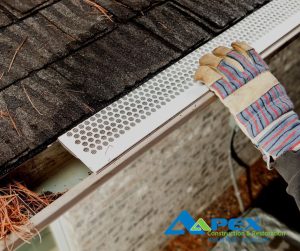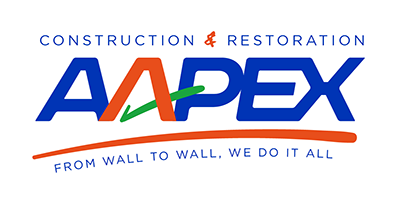What is Gutter Guard?
Gutter guards serve as a protection system for your gutters. They’re used to keep things out of your gutters. These guard pieces attach overtop of your gutters. They stop and prevent your gutters from clogging and overflowing. They can prevent damage not only to your gutters but also your landscape, roof, and foundation. They’re supposed to allow for less frequent gutter cleanings. This means you can go longer periods between gutter cleanings. They’re also used to protect your gutters and help them maintain their lifespan. The protection causes gutters to rust and rot slower than normal. There are many different types of gutter guards. They vary in prices, materials, shapes, and sizes.
Can You Install Gutter Guards to Old Gutters?

Many types of gutter guards do install over existing gutters. Most types are easy and quick to install, especially by professionals. You can install most gutter guards by yourself, but the easiest way is to hire a professional. It leaves less room for error and gives your existing gutters the best chance. Many gutter guards that install over existing gutters are easy to remove. This can be beneficial for cleaning. If you’re existing gutters are in good condition, guards can save you money in the long run. Yes, you’re paying for the guards up front, but they can prolong the life of your existing gutters. This will give them a longer lifespan, allowing you to replace them less often. You have options with different price points and different capabilities. A professional will also help you weigh out those options and choose the best for your needs and budget. Different guards can be beneficial for different needs, and you might not know what you need. Installing over old gutter guards can offer many benefits. As with anything though, different types of guards offer both advantages and challenges.
What Gutter Guard Should I use?
According to a licensed home inspector, four types of guards are easiest to install. All four are common in the gutter guard industry. The different materials offer different levels of simplicity, but they’re all doable. Each type of gutter guard also has both pros and cons to take into consideration. So, what’s important to know about each gutter guard?
Types of Gutter Guards
- Micromesh- Mesh system gutter guards are one of the most popular choices. They have a simple design, two strips of material with a fine mesh between them. The mesh keeps debris out. Micromesh gutter guards work well with existing gutters. An installer would only have to slip one end under the shingle. The other end attaches to the outer edge of the gutter. You can also curl the mesh into an L on one end and screw it into the fascia under the roof. The other end would slip into the gutter for a tight fit. Different types of mesh guards have different fineness. You can choose what works best for cleaning your gutters.
- Brush Inserts- Brush inserts are one of the least complicated gutter guards you can use. They have two components: a stainless-steel wire spine and polypropylene brush filaments. These filaments can withstand any weather condition. You can install these inserts yourself. All you need is to get the right fit and lay the inserts inside your existing gutters. The filaments keep debris out, allowing only water to pass through. In principle, it sounds easy. It’s not always as easy as it sounds though. These accumulate finer particles.
- Screen- These are a stronger, more perforated version of mesh gutter guards. They come in aluminum material and a variety of styles. Styles include:
- K-Style Drop-In screen guards
- K-Style Lock On-screen guards
- K-Style Hinged screen guards
- Half Round Hinged
- Reverse Curve- Water runs down the roof towards the gutter. It slides off the top, flows down the bend at the edge, and spills backward into the gutter. The bigger leaves get washed down to the ground. Surface tension directs water into the gutter and down the downspout. They don’t filter the debris to keep them on the gutter guard. They direct as much water with as little debris as possible. Most reverse curve gutter guards have a ⅜ inch opening for the water. They can take up to 22 inches of rainfall at a time – which is plenty more than you’ll need in the US.
The Downsides of Each Type

- Micromesh- Both installation styles have flaws. The under-shingle micromesh has an angle that makes water glide over the gutter. It travels down to the foundational edge of the house. Over time, it will erode that area or even cause some flooding. The second installation style, where the guard is flat, tends to leave the leaves bulked on top of the mesh. Finer particles clog the tiny holes, forcing you to bring out the power washer to clean the mesh.
- Brush Inserts- They’re easy to manage, but they will still accumulate finer particles. Also, they don’t keep out tiny twigs, seeds, or pines. You’ll still have to take the inserts out and clean out the gutters.
- Screen- Screen guards gather bigger debris over a shorter time compared to micromesh. Buildup of debris can make the gutters heavy. This can destroy your roof and put the entire gutter at risk. Screen gutters installed under the shingles can void the roof’s warranty. It distorts the roof.
- Reverse Curve- Reverse curve gutter guards are notorious for ice dams. You lift the shingle at an angle when you install them. Water on aluminum freezes quick. This turns the water underneath the shingle into icicles. They’re not 100% effective in keeping the rainwater in and the debris out. They also are the perfect spot for insects and plants. They provide shade, dirt, and a wet spot. Plants will likely take root there if seeds germinate. Insects such as bees and wasps will make their colonies in that space.
To Conclude
Yes, it’s definitely possible to install gutter guards on top of your existing gutters. If your gutters are in good condition and don’t need replaced it should be a simple process. Having the right professional help will make this simple process even easier. There are many different types of gutter guards to choose from. Your budget, needs, and existing gutters will have a say in the gutter guards best suited for you. As with everything, each type of gutter guard comes with advantages and disadvantages. It can be hard to understand those advantages and disadvantages. Understanding them will help you can choose the right option for you. We’re here to help you find the best plan for your gutters. Whether that’s replacement, adding gutter guards, or doing both, we want to help. Contact us today to get a quote or learn more!



You’re absolutely right that clogged gutters can lead to a range of problems, from unsightly stains on your siding to more serious issues like foundation damage and pest infestations. That’s why we recommend having your gutters professionally cleaned at least once a year, or more frequently if you have a lot of trees near your home.